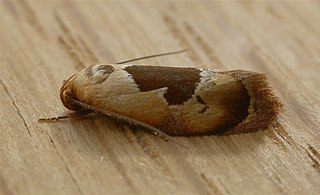Related Research Articles

Hoplomorpha camelaea is a moth in the family Oecophoridae first described by Edward Meyrick in 1888. It is found in Australia, where it has been recorded from Victoria, Queensland, New South Wales and the Australian Capital Territory.
Helcystogramma bicuneum is a moth in the family Gelechiidae. It was described by Edward Meyrick in 1911. It is known from north-eastern India and China.

Pyrgotis plinthoglypta is a species of moth of the family Tortricidae. It is endemic to New Zealand and is found throughout the whole country. The preferred habitat of this species is native forest. The larvae of this species feeds on rimu leaves from under a silken web. It pupates in loose cocoons amongst rimu foliage. Adults are on the wing from October to May and are night flying. They are attracted to light and can be collected by beating their host tree. The adult insect resembles a small dried fragment of rimu foliage when at rest.
Catacometes hemiscia is a moth in the family Oecophoridae. It was described by Edward Meyrick in 1883. It is found in Australia, where it has been recorded from New South Wales.
Hoplomorpha teratopa is a moth in the family Oecophoridae. It was described by Edward Meyrick in 1920. It is found in Australia, where it has been recorded from New South Wales.
Garrha cholodella is a moth in the family Oecophoridae. It was described by Edward Meyrick in 1883. It is found in Australia, where it has been recorded from New South Wales.
Hoplomorpha notatana is a moth in the family Oecophoridae. It was described by Francis Walker in 1863. It is found in Australia, where it has been recorded from Queensland.
Helcystogramma adaequata is a moth in the family Gelechiidae. It was described by Edward Meyrick in 1914. It is found in Guyana.
Helcystogramma symbolica is a moth in the family Gelechiidae. It was described by Edward Meyrick in 1914. It is found in Guyana.
Ethirostoma semiacma is a moth in the family Gelechiidae. It was described by Edward Meyrick in 1914. It is found in Guyana.
Idiophantis carpotoma is a moth of the family Gelechiidae. It was described by Edward Meyrick in 1916. It is found in southern India.
Semnostoma barathrota is a moth of the family Gelechiidae. It was described by Edward Meyrick in 1918. It is found in Assam, India.
Stenoma eva is a moth of the family Depressariidae. It is found in Guyana.
Antaeotricha melanarma is a species of moth of the family Depressariidae. It is found in French Guiana.
Antaeotricha axena is a moth of the family Depressariidae. It is found in French Guiana.
Dinochares conotoma is a moth in the family Lecithoceridae. It was described by Edward Meyrick in 1908. It is found in Sri Lanka.
Comotechna parmifera is a moth in the family Depressariidae. It was described by Edward Meyrick in 1921. It is found in Peru and Pará, Brazil.
Comotechna scutulata is a moth in the family Depressariidae. It was described by Edward Meyrick in 1921. It is found in Brazil.
Psittacastis trierica is a moth in the family Depressariidae. It was described by Edward Meyrick in 1909. It is found in Bolivia.
Antaeotricha nitescens is a species of moth in the family Depressariidae. It was described by Edward Meyrick in 1925. It is found in Brazil (Para).
References
- ↑ Beccaloni, G.; Scoble, M.; Kitching, I.; Simonsen, T.; Robinson, G.; Pitkin, B.; Hine, A.; Lyal, C., eds. (2003). "Hoplomorpha epicosma". The Global Lepidoptera Names Index . Natural History Museum . Retrieved 25 May 2018.
- ↑ Savela, Markku, ed. (6 January 2014). "Hoplomorpha epicosma Turner, 1916". Lepidoptera and Some Other Life Forms. Retrieved 13 September 2020.
- ↑ Proceedings of the Linnean Society of New South Wales. 41 (2): 374.
 This article incorporates text from this source, which is in the public domain .
This article incorporates text from this source, which is in the public domain .